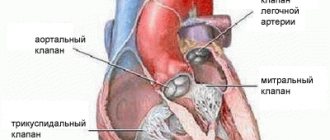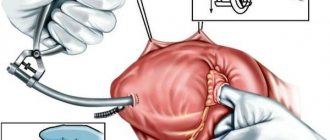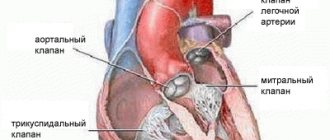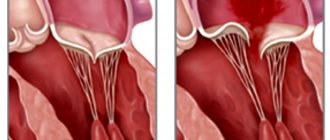Sign up
+7
Cardiac surgery is one of the most difficult operations. The aortic valve replacement uses a miniature part created in a high-tech laboratory. Installing such a prosthesis is a painstaking and extremely responsible task, which only an experienced surgeon can handle. The operation requires serious preparation, and the recovery period also requires effort on the part of the patient.
When is valve replacement required?
The heart is responsible for delivering blood and oxygen to all tissues of the body. Any disturbances in the functioning of the organ inevitably have a negative effect on the body and require treatment. Often the problem can be solved conservatively, that is, without resorting to invasive intervention. But this does not always happen, and in some cases surgical replacement of the aortic valve cannot be avoided. The main problems of the aortic valve include:
- Congenital and acquired defects. This category includes any changes that interfere with normal blood flow and increase the workload of the heart.
- Valve stenosis, in which the ejection of blood into the aorta is impeded.
- Rheumatic diseases, streptococcal infection.
- Aneurysm, aortic dissection.
- Change in shape, valve damage, calcification, sagging valves.
- The valve does not close tightly, blood flows in the opposite direction.
- Inflammation.
Make an appointment with a specialist without queues, at a convenient time
Sign up
+7
When the pathology is at an early stage of development, it can often be eliminated without surgery. In serious cases, when medications cannot solve the problem, surgery is used. An artificial valve made in the laboratory, as well as an element of the patient’s own tissues, can be installed. The second option is cheaper, since you do not need to purchase an expensive prosthesis.
Risks and complications
- postoperative bleeding;
- inflammatory process of a postoperative wound;
- respiratory complications;
- heart rhythm disturbances;
- pain associated with nerve fibers, muscle spasm or dislocation of costal cartilage;
- encephalopathy;
- problems with a retained valve or prosthesis;
- cardiac weakness, perioperative myocardial damage, stroke, death.
You should contact your doctor if you feel the following:
- rapid breathing at rest or after slight exertion;
- heart rhythm disturbances;
- an increase in body weight by 1 kg in one day, or by 2.5 kg in 7 days, or swelling has appeared in the lower extremities;
- dizziness, weakness;
- temperature rise above 37.8C;
- changes in the postoperative wound (redness, discharge, swelling, pain);
- chest pain;
- pathological mobility, clicking of the sternum.
Anyone can calculate the risk of surgery using the international table for calculating the risk of cardiac surgery EuroSCORE II, which takes a few minutes.
What types of valves are there?
Three types of elements can be used to replace an unhealthy valve:
- Biological. They suggest recreating a new valve from the patient’s own tissues. Such a valve will last about 10-15 years, after which the operation will need to be repeated. This is due to the gradual wear and tear of the element and its inevitable degenerative changes. With this approach, anticoagulants need to be taken only for the first six months after surgery.
- Mechanical. Such a valve is manufactured in a laboratory and requires constant use of anticoagulants (for the entire life of the patient). Such prostheses are installed mainly in patients who have not reached old age.
- Donor. This option is used only in extreme cases, as there is a risk of rejection of donor tissue by the patient's body. The outcome of such an operation is difficult to predict, and the possibility of complications cannot be excluded. In order for the valve to take root, doctors need to carry out therapy that suppresses the recipient’s immunity so that the immune system does not begin to fight the foreign element. As with the installation of an artificial valve, the patient is advised to take lifelong anticoagulants to exclude the possibility of thrombus formation.
- Available: doctor’s appointment from 1500 rubles
- Convenient: open daily from 8:00 to 21:00
- Quickly: we will carry out all the diagnostics at the first appointment
- Complete: has all the necessary equipment
Method of mitral heart valve replacement, effectiveness of the operation and prognosis
Mitral valve replacement is an operation to replace one (several) valves with a prosthesis (biological and artificial). The procedure significantly prolongs the life of patients with heart pathologies and minimizes the manifestation of symptoms of the disease. This is a good alternative to heart transplant surgery instead of the long wait for a donor.
A defective bicuspid heart valve must be replaced, the reason why is calcification, heart failure, fibrous condition of the valves. Cardioplegia or AIC is used, during which long-lasting mechanical (tissue) valves are installed. They can reduce the risk of developing thromboembolism and endocarditis.
Varieties
The most durable prosthesis with excellent survival rate and a low threshold for the development of infection is the pulmonary valve, the installation of which is often performed in young patients aged 20-25 years, who can easily survive a complex operation.
In older patients, surgeons often install the patient's own heart valve instead of the aortic one.
Substitutes used:
- disc prostheses;
- hinged bicuspid dentures;
- from pork heart with a high risk of thrombosis.
8
24/7
The disadvantage of outdated disc models is the high risk of complications: ischemic stroke, femoral thrombosis and pulmonary embolism, thrombus formation in the valve leaflets.
- Mechanical valves, made of synthetic semi-circular structures, move in one direction, are durable, strong and wear-resistant. Patients after surgery require lifelong anticoagulant therapy.
- Biological artificial models made from pig hearts wear out quickly. The service life does not exceed 12 years, so for elderly patients after 65 years of age, the best prosthetic option is to install their own pulmonary valve. The risk of developing re-inflammation remains.
Manufacturers guarantee a service life of mechanical valves of up to 15 years, although they may wear out faster. Often, after 7-8 years, patients need repeat surgery. In the case of mitral valve replacement, the price depends on the type of prosthesis.
Indications for prosthetics
Mitral valve replacement is associated with certain risks and is considered a technically difficult procedure. Doctors of various profiles, most often cardiac surgeons, take part in it. With a defect, a large load is placed on the heart, which can complicate the surgical procedure.
Mitral valve replacement is fraught with complications, although to this day the operation remains in demand when drug treatment is ineffective.
Main indications for prosthetics:
- mitral valve insufficiency;
- fibrosclerosis;
- stenosis;
- deposition of calcium salts;
- wrinkling or shortening of the gate;
- narrowing of the valve in the hole;
- impossibility of eliminating the defect by cutting the valves;
- sclerosis of the tendinous chord.
Surgical correction is required when there are structural changes in the mitral part of the valve, when blood flow is clearly impaired, or when blood flows in only one direction.
Contraindications
Mitral valve replacement may become dangerous and ineffective if the patient has:
- blood clotting disorder;
- chronic diseases of internal organs;
- severe form of heart disease.
Preparing for surgery
The preparatory stage before mitral valve replacement consists of examining the patient:
- chest x-ray;
- general urine analysis;
- blood test for biochemistry;
- blood clotting test;
- Ultrasound of the heart and blood vessels;
- electrocardiography;
- coronary angiography for medical reasons.
Patients need to consult a therapist, cardiologist, and anesthesiologist.
The main preparatory procedures are taking a contrast shower and the last meal 8 hours before surgery. You need to get a good night's sleep and calm down.
Prosthetic methods
Mitral valve replacement on the heart is performed using an open or endovascular method.
Open intervention
Open surgery under anesthesia (anesthesia) involves the surgeon working on the anterior surface of the chest with dissection of the sternum in the longitudinal direction, opening the pericardial cavity.
The patient is connected to a heart-lung machine to disconnect the valve from the systemic circulation. An implant is installed on a non-functioning heart to avoid myocardial hypoxia. Also, throughout the entire procedure, the affected organ is treated with cold saline solution.
The open method of surgery is highly traumatic, the recovery period is long.
When suturing the surgical wound, sensors can be applied for temporary cardiac stimulation, and wire sutures can be applied to the edges of the sternum for rapid tissue fusion.
8
24/7
Endovascular intervention
The technique does not require anesthesia. It is performed on a beating heart and without connecting a heart-lung machine. A catheter is inserted into the heart cavity and an implanted valve is inserted. The process of implanting a valve into a damaged area is often quick and easy, since the implant is quite flexible and plastic. Additionally, if necessary, stenting of the coronary vessels is performed.
The endovascular method is minimally invasive. If the vessels and the mitral valve are simultaneously affected, and patients have atherosclerosis, then doctors can eliminate 2-3 pathologies at once in one operation.
Inaccessible method
The method is minimally invasive, since an operation is performed to replace the mitral valve with an incision of the anterior chest wall of only 2.5 cm. A catheter is inserted into the affected area of the valve through the projection of the apex of the heart. Then, by analogy, as with the endovascular technique, the surgeon performs the implantation of the implant.
The choice of type of prosthesis and technique directly depends on the technical equipment of the clinic, the patient’s well-being, and existing contraindications. Open intervention on the mitral valve is considered the most dangerous and traumatic. The endovascular technique is more advanced, but expensive. Although the advantages are obvious, it is allowed to be performed on both young and elderly patients.
For young patients, doctors can offer vulvoplasty as a safe method of mitral valve replacement, reviews of which confirm its effectiveness. The operation is carried out without installing an artificial prosthesis, solely due to the expansion of the lumen of the artery of its own valve during surgical manipulations.
Period after surgery
The operated patient is placed in the intensive care unit for a day. If the condition on the second day is satisfactory, then he is transferred to a regular ward.
If the mitral valve replacement surgery was performed in an open manner, daily treatment of the sutures with antiseptics is necessary for 7-10 days. If an endovascular technique was performed, then after 3-4 days the patient goes home.
After the intervention, unpleasant sensations may be observed for a month: burning and chest pain. The open method of surgery leads to nagging pain in the heart area, redness and swelling at the suture sites.
If the wound has festered, you should definitely see a doctor for antiseptic treatment.
The rehabilitation period averages 6-8 months. Additionally, patients are prescribed drug therapy:
- anticoagulants for blood thinning;
- painkillers;
- antibiotics if there is a high probability of wound infection after surgery;
- beta blockers, calcium antagonists;
- ACE inhibitors;
- diuretics if patients have hypertension, angina, arrhythmia.
Blood clotting tests are performed regularly, as is monitoring of INR levels. The examination helps prevent stroke and bleeding, which can be caused by a foreign object in the heart.
Against the background of the operation, the following conditions are not uncommon:
- emotional lability;
- insomnia;
- apathy;
- decreased vision;
- depression.
Installing a prosthesis on the heart necessarily requires a radical revision of lifestyle and nutrition, and giving up bad habits. For the first time after surgery, you should come to see a cardiologist in a month. Donate blood and urine. If the indicators are normal, then the next time you will have to visit the doctor in a year.
It is important to review your diet and exclude fried, smoked, salty and fatty foods. Give preference to vegetables, lean fish and meat.
Mitral valve replacement is a restoration of ventricular function and cardiac contractility, and a reduction in intraventricular pressure.
Even a successfully performed surgical intervention to replace the mitral heart valve does not provide a 100% cure prognosis.
It is worth understanding that even the best dentures are not eternal and have a limited service life. After mitral valve replacement, a repeat operation may be required. That is why it is extremely important to identify malfunctions of the implant in a timely manner, because the individual characteristics of the heart do not always coincide with the artificially installed valve. Reduced pressure inside organs remains in patients for life and requires regular attention from a cardiologist.
8
24/7
What types of operations are used
Aortic valve reconstruction or replacement can be performed in two ways:
- On an open heart.
- Minimally invasive method.
Modern cardiac surgery actively uses methods that make it possible to replace heart valves without cutting the chest. An operation without an opening will cost more than a classic open one. This approach reduces the likelihood of risks and facilitates the recovery period. Access can be through an artery in the shoulder or leg using a catheter. Local or general anesthesia is required, the total time of the operation using a catheter is about one to one and a half hours.
Abdominal surgery with an incision in the chest lasts longer and is cheaper compared to minimally invasive surgery. During valve replacement, the patient is connected to an artificial circulatory system. The risk for the patient is slightly higher than with the endoscopic method, but there is no risk of deformation of the conducting vessels.
Modern techniques are available in clinics in Israel and Germany.
Indications and contraindications for surgery
Indications:
- congenital heart defects;
- lack of results of drug treatment for chronic heart failure accompanying mitral valve stenosis;
- fainting with aortic stenosis;
- aortic valve stenosis, manifested after coronary artery bypass grafting;
- valve calcification.
Contraindications:
- heart attack;
- stroke;
- extreme degree of heart failure with mitral valve stenosis;
- endocarditis.
Postoperative period
The recovery period is the most important stage, which has its own characteristics. For the first time after replacing the valve, physical activity and strong psychological experiences are prohibited. Caution must be exercised for at least three years after the intervention. Professional athletes can return to full training only after six years. Taking anticoagulants prescribed by a doctor is a must. It is also very important to regularly check the condition of the body and monitor for possible concomitant pathologies.
In fact, the valve itself will not affect the patient's future health in any way. If irreversible changes have occurred, the patient needs constant monitoring by a cardiologist.
Minimally invasive interventions
They differ from open surgery in two important aspects. Instead of one large incision through the breastbone, the surgeon makes several small ones through the chest wall. The surgeon can perform surgery on the beating heart, which reduces the risk of stroke (more common in myocardial revascularization surgery).
Advantages:
- shorter length of hospital stay;
- fast rehabilitation period;
- less scarring;
- fewer complications associated with artificial circulation.
Only a surgeon can determine indications for minimally invasive intervention. If complications arise, conversion to a standard “open” operation with artificial circulation is possible.
Where to get treatment
collaborates with the National Medical Research Center of Cardiology, which is an expert center for aortic valve replacement in the Russian Federation with experience of more than 1000 implantations.
The clinic is equipped with the latest equipment and software of the latest generation (such as intracardiac and intravascular navigation systems), which allow achieving maximum treatment results with minimal risks of complications. The specialists of our clinic are world-class experts in the field of transcatheter treatment of the heart valve apparatus, who perform TIAC procedures both in the Russian Federation and abroad.
After operation
In general, rehabilitation and recovery after CABG without artificial circulation is faster and easier. If the early postoperative period passes without complications, then after a day the catheters are removed and the patient is transferred to the department, where he remains for up to 7-10 days. There the condition of the heart and the whole body will be monitored.
In the postoperative period, a rehabilitation plan is individually selected for the patient and physical therapy is prescribed.
A good method of maintaining health is walking for 10 minutes at the very beginning (after you are allowed to walk) to 30-60 minutes 2-3 weeks after surgery.
It is important that during physical activity, the heart rate does not rise above 100-115 beats per minute and there is no shortness of breath.
If, after the operation and the rehabilitation period in the ward - in the cardiac surgery department, you are worried about independent recovery, you can undergo a rehabilitation program at our center.
Upon discharge from the hospital, the attending physician will issue a reminder about the rules of prevention after surgery and prescribe medications. Taking any other medications, including those from your home medicine cabinet, should be agreed with a cardiologist.
Smoking and drinking alcohol after CABG surgery are prohibited for life. You will also need to follow a diet with a reduced content of salt, fats, and sweets.
Afterwards, you will need to undergo a heart study at 1 month, 3, 6, 12 months. You can also do this in our center.
About CABG surgery
Coronary artery bypass grafting (CABG) is one of the most effective methods in the treatment of coronary heart disease (CHD).
The operation is performed on a beating heart, without the use of artificial circulation, and is indicated in cases where damage to the arteries of the heart is so severe that the use of other methods of restoring coronary blood flow is impossible. In our clinic of the Federal Scientific and Clinical Center of Federal Medical and Biological Agency, coronary bypass surgery is performed using several methods:
- on a “working” heart without the use of artificial circulation;
- on a beating heart under conditions of assisted artificial circulation.
Reviews from doctors
Professor Ran Kornovsky, Director of the Institute of Invasive Cardiology at Beilinson Hospital: “I am very pleased that we were able to perform valve replacement surgery quickly and gracefully, with minimal harm to the patient. To date, less than 20 such procedures have been registered worldwide and none in Israel. In this way, we continue to build on the already extensive experience we have acquired in the field of heart valve replacement through catheterization and other varied and complex procedures.”
Professor Alik Sagi, Director of the Institute of Echocardiography (Echography) and the Valve Diseases Clinic at Beilinson Hospital: “This is a real revolution. Repeated surgical interventions on the heart in patients who have previously undergone similar operations are associated with a long and difficult recovery process, sometimes stretching for several months. Two days after our procedure, the patient was already moving around the department, and we observed a significant improvement in her clinical condition.









